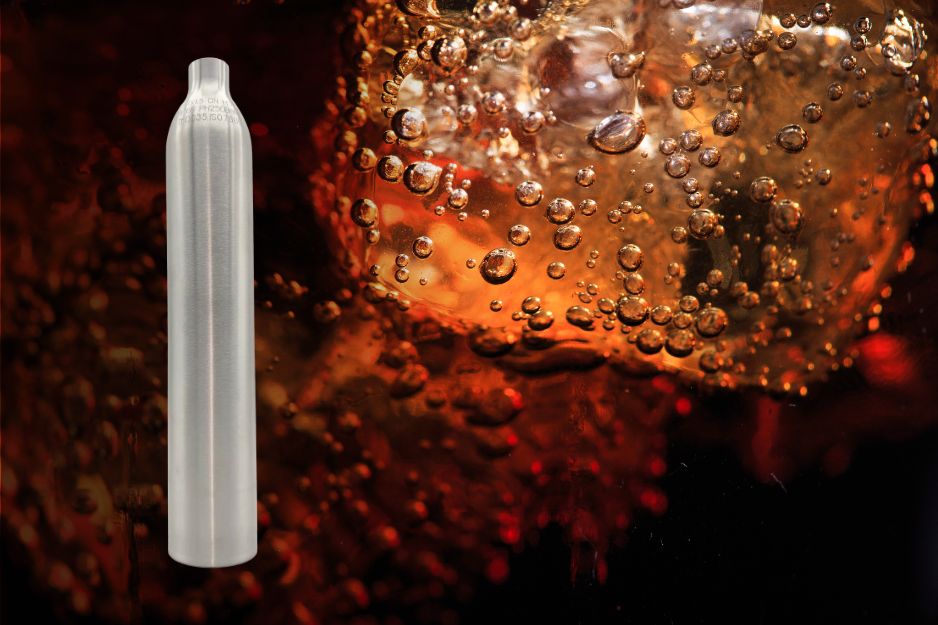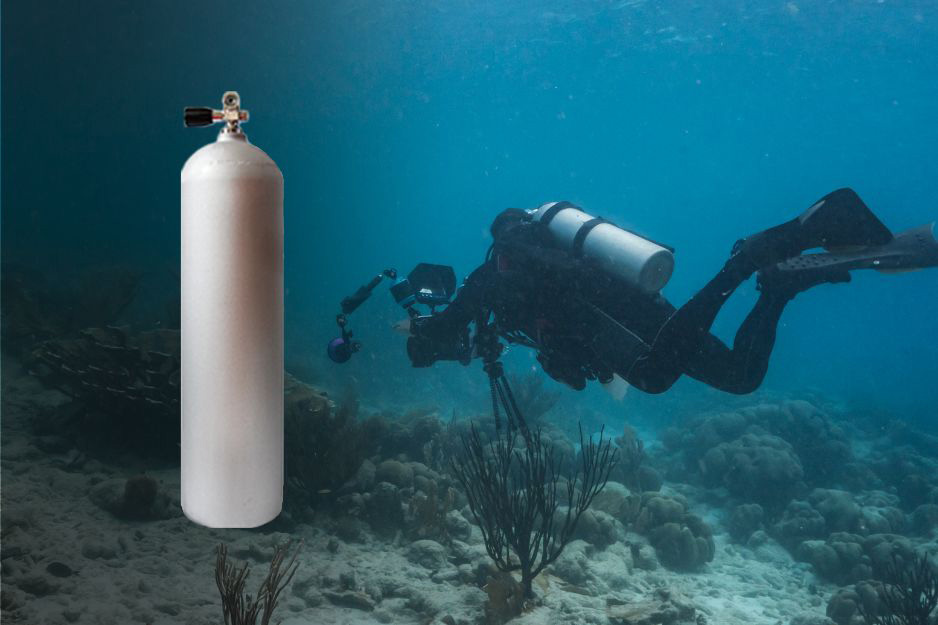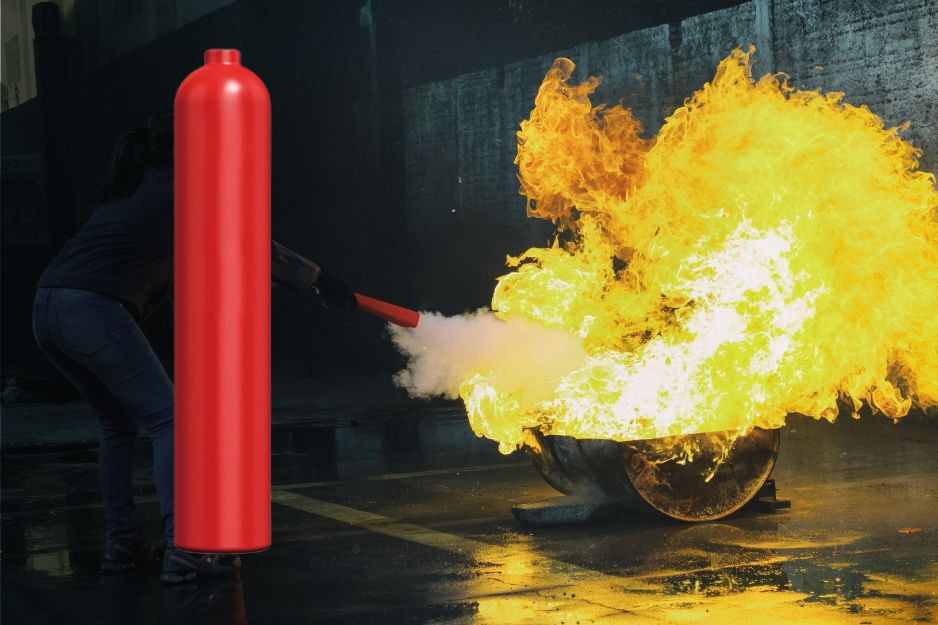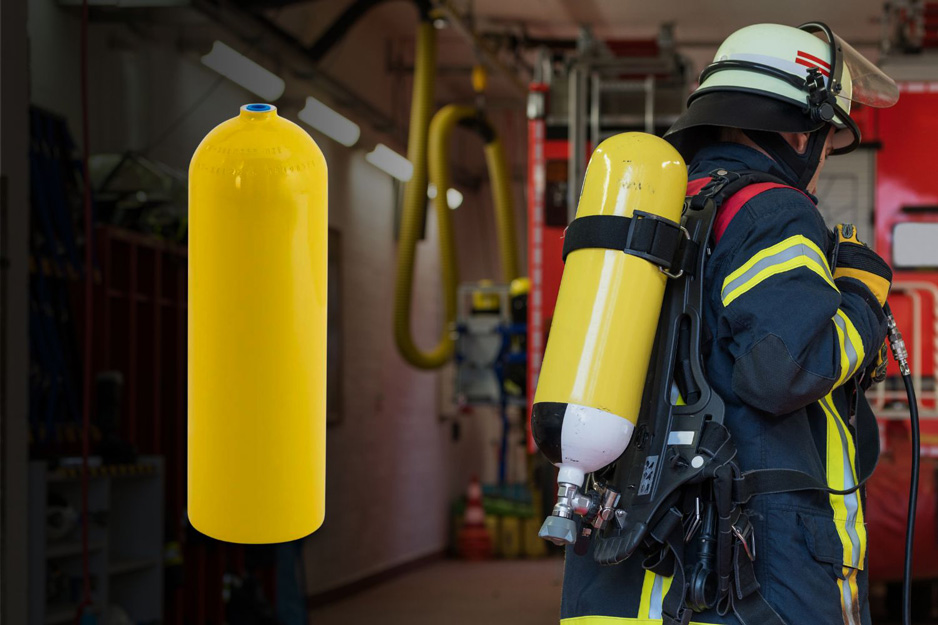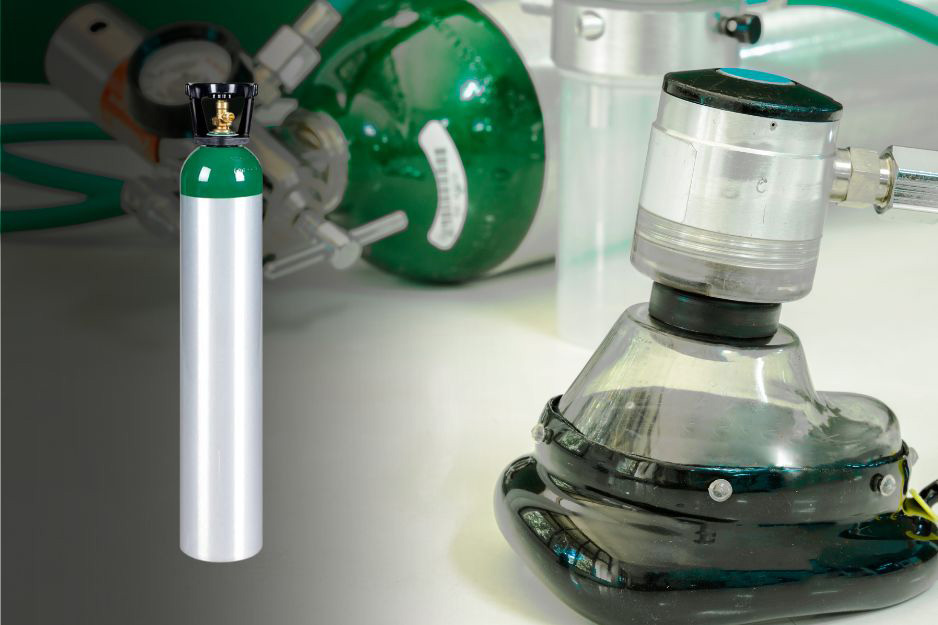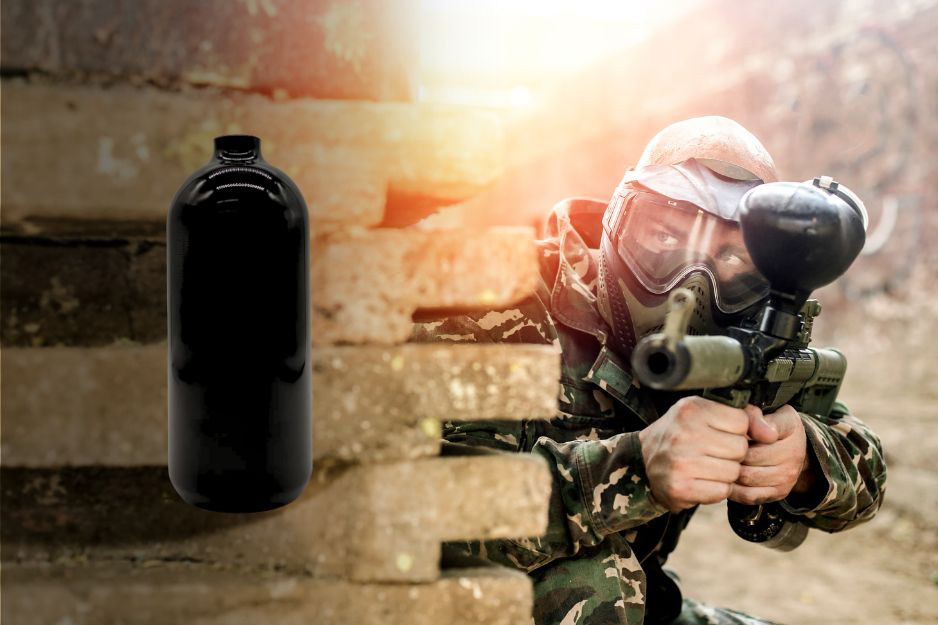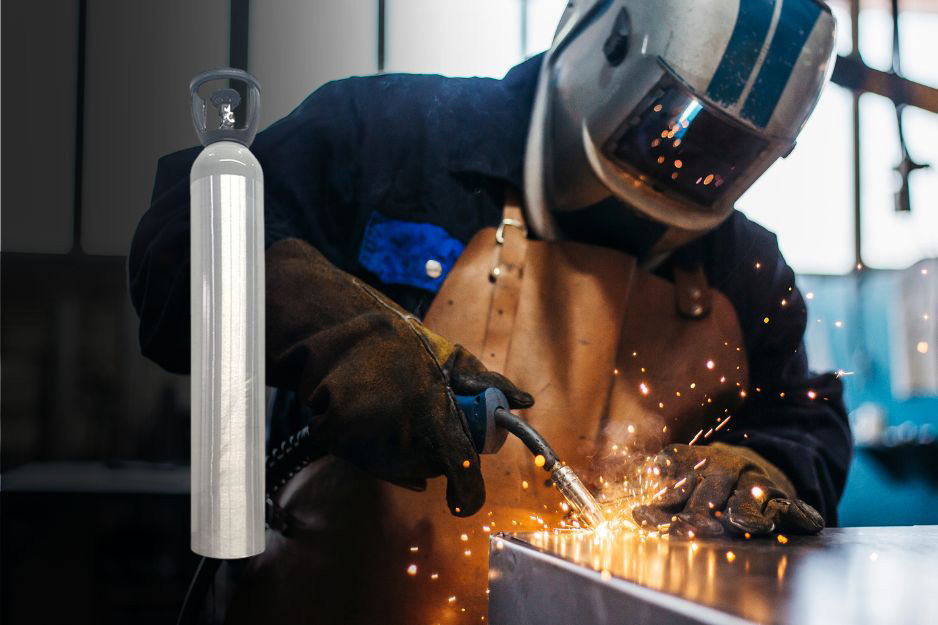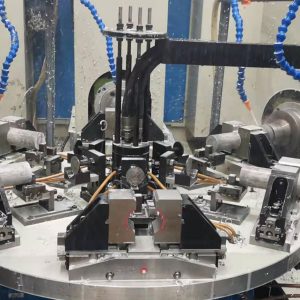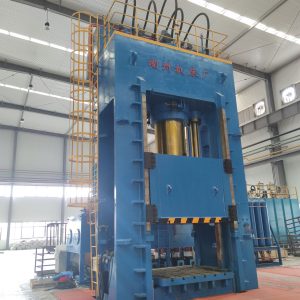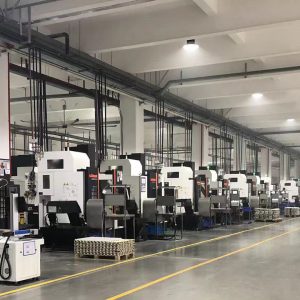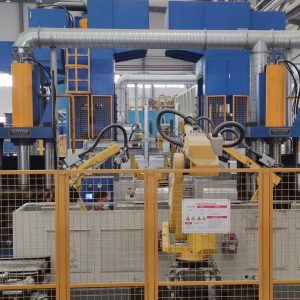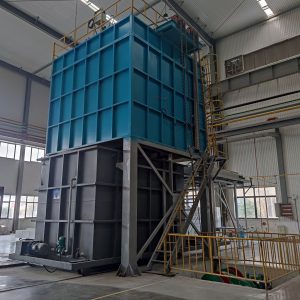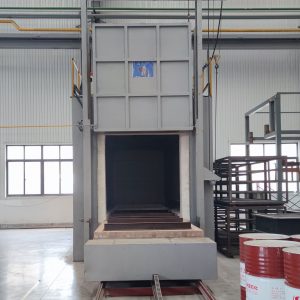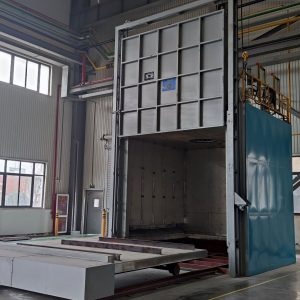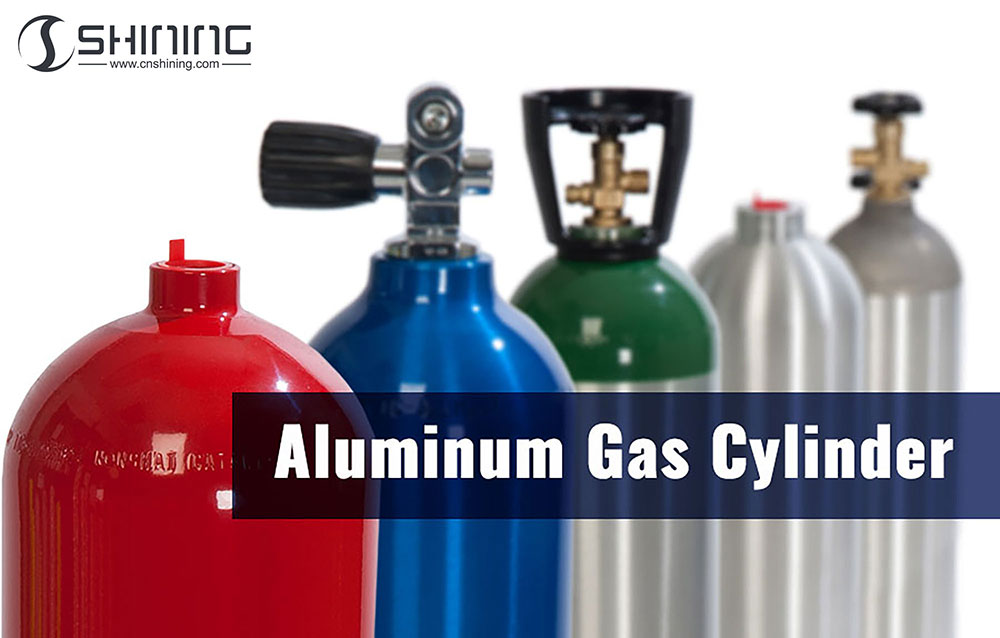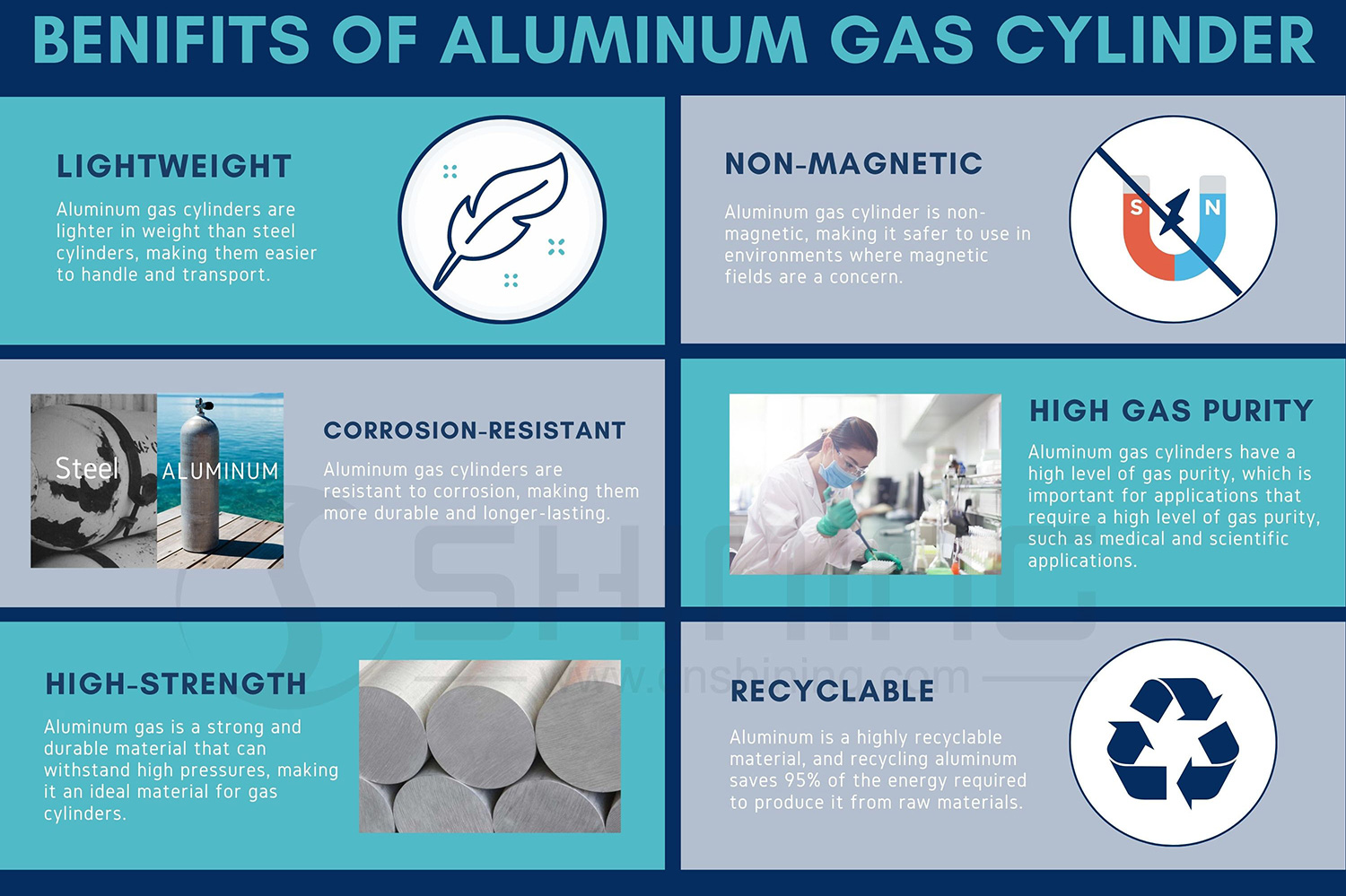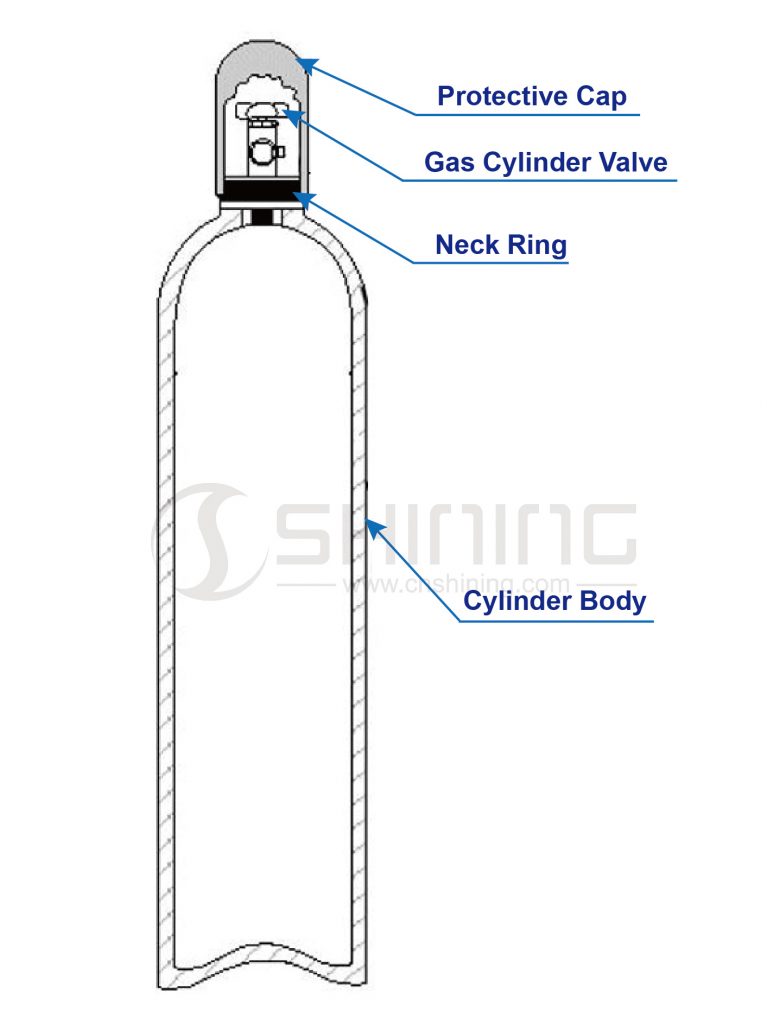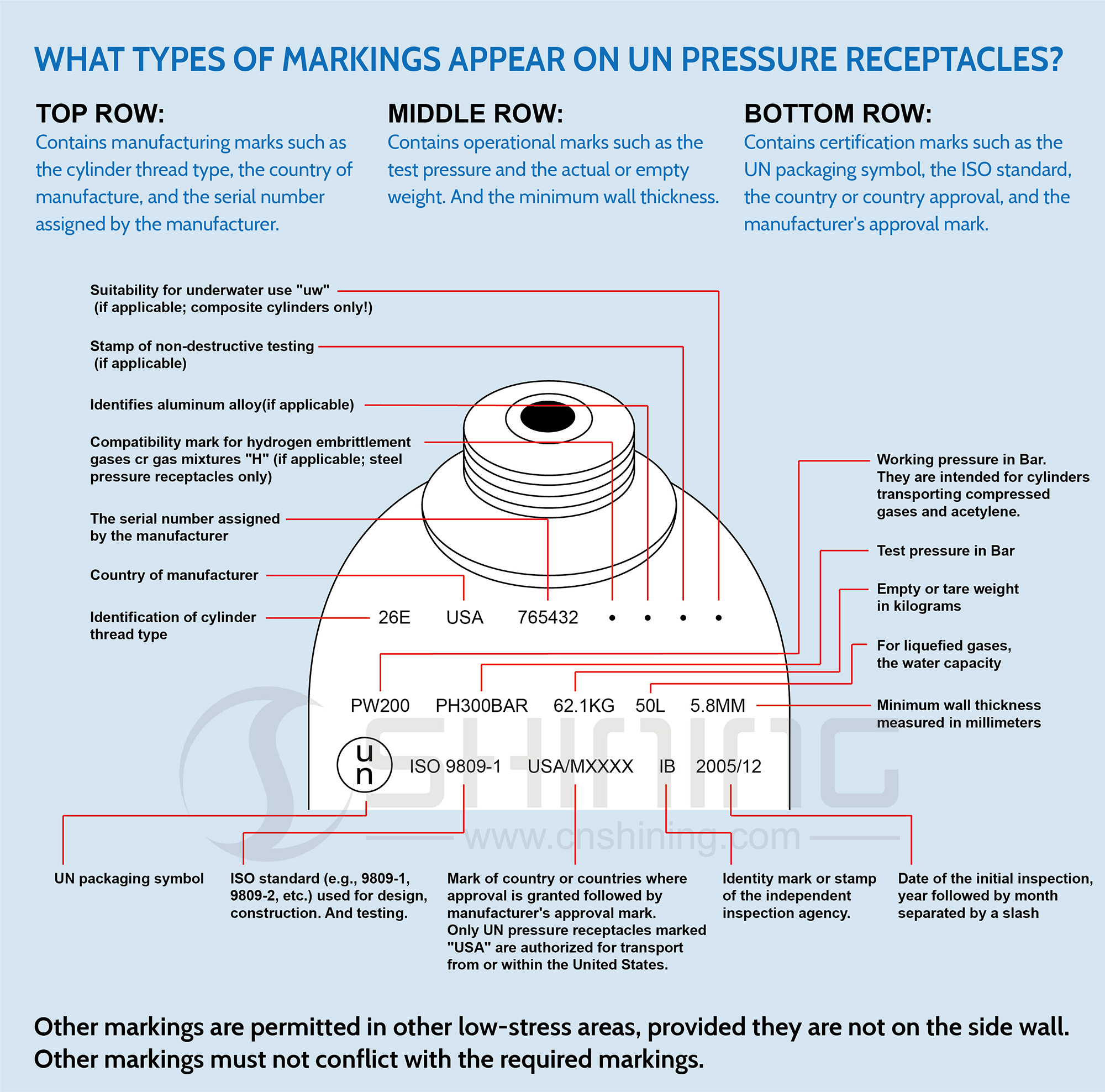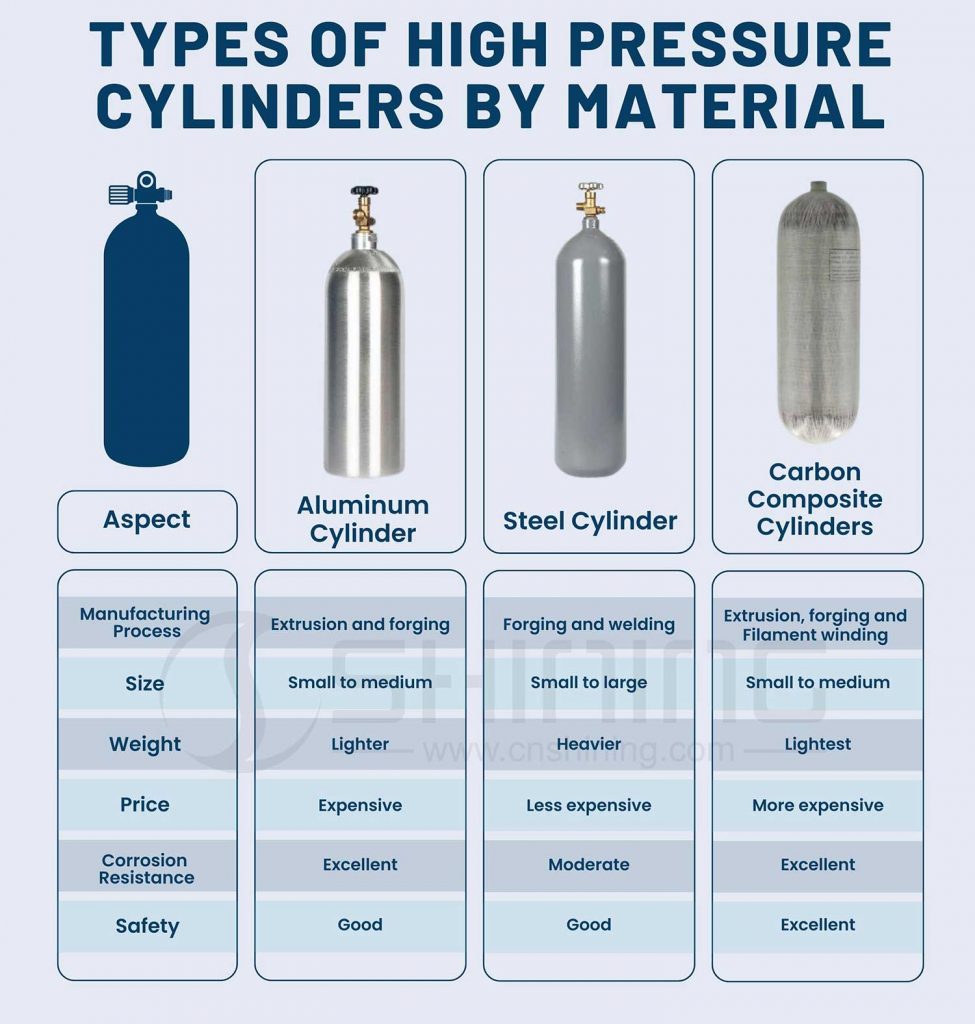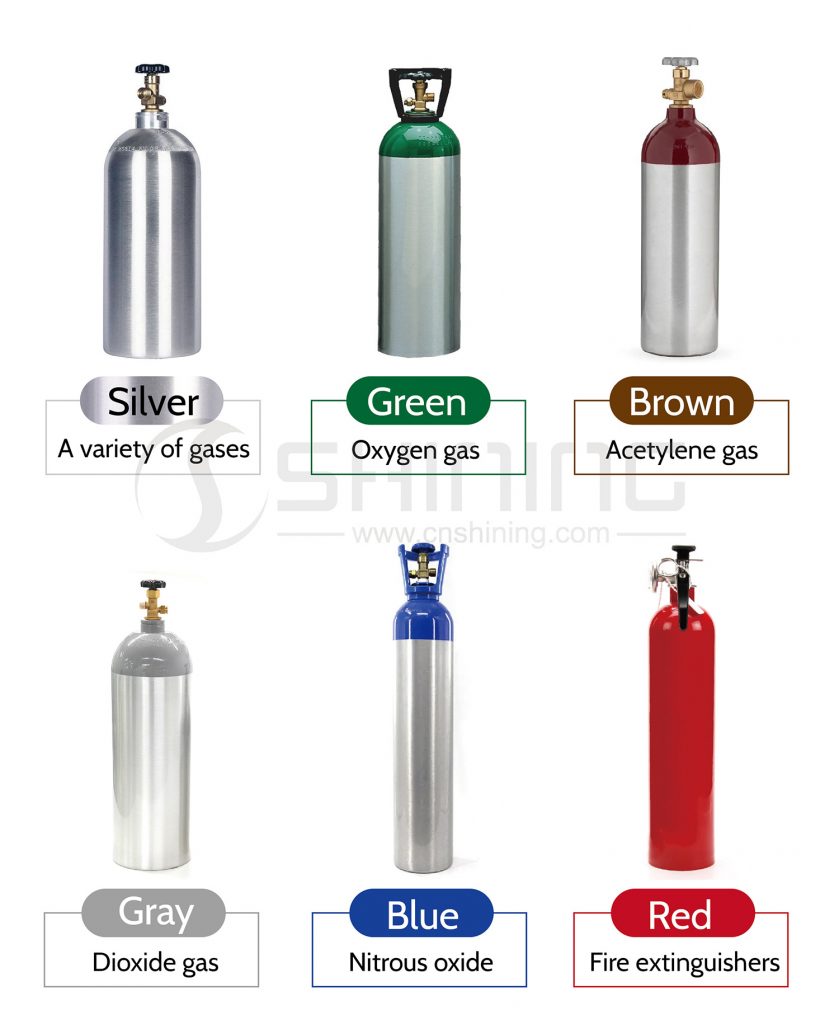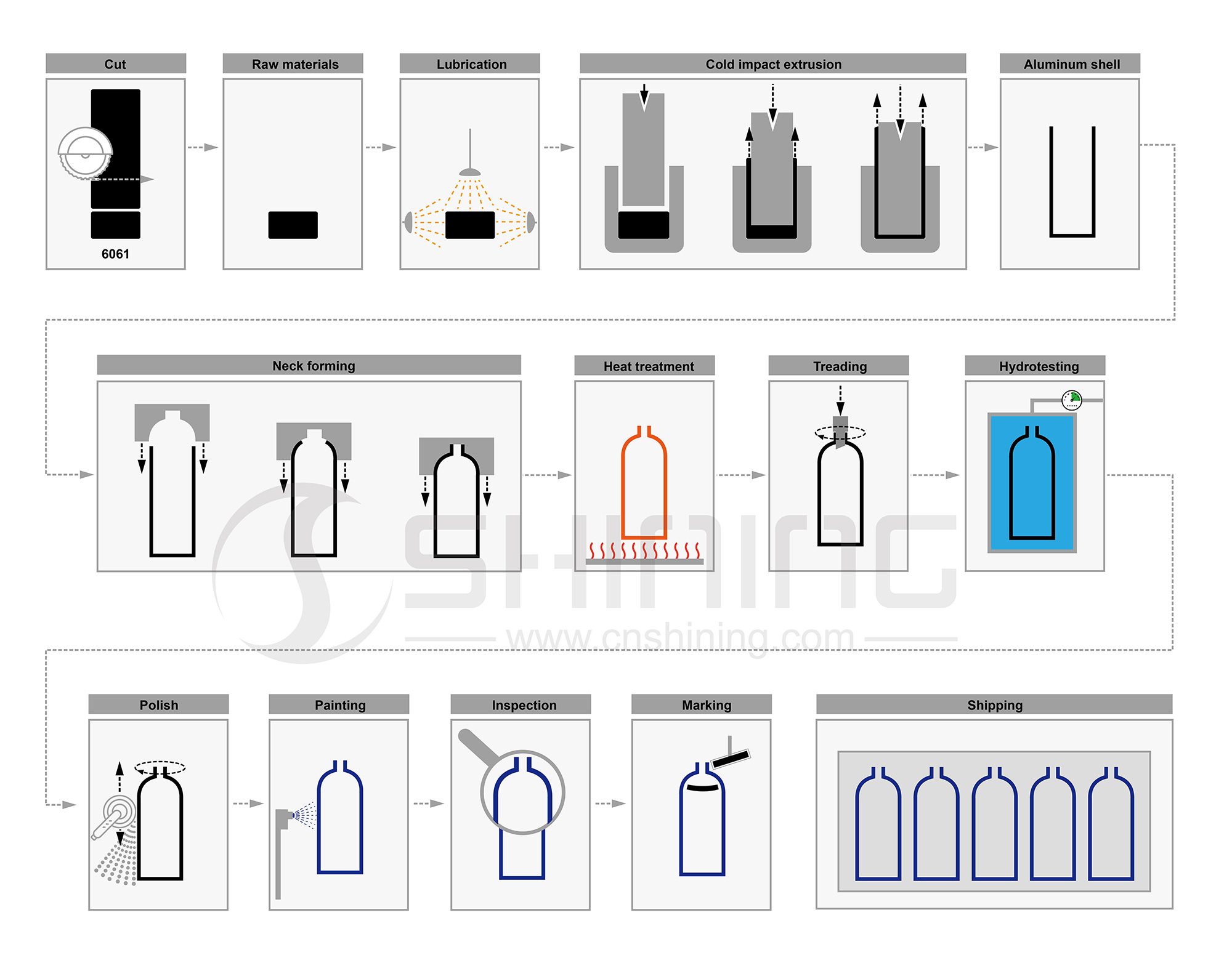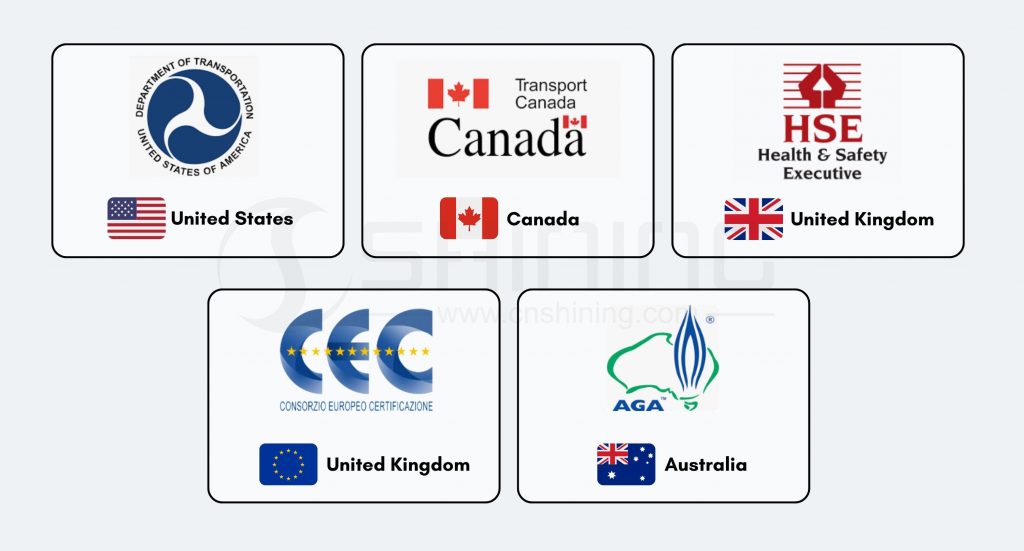Shining Aluminium Packaging is a leading supplier of high-pressure gas cylinders in China. We have donated ourselves to the research and development of cylinders since 2001, aiming to provide excellent quality products for beverage, scuba, medical, fire safety and special industries.
Aluminum Gas Cylinder Manufacturer
equipment
Our quality control is ensured by strict conformity to the international standards including ISO, DOT and TPED, we are equipped with advanced automatic machinery and production systems under ISO9001 to meet or exceed the requirements and expectations of our customers and international standards.
Testimonials
As we really appreciate your service and your very good quality of Printing and Aluminum products, we think of you as our reference supplier in any new project containing Aluminum packaging.
Wafaa Halloum Project Officer
You've been a great partner of ours and we hope you understand our need for additional flexibility during this most unusual time.
Chris ThoweCOO
Previous
Next
Looking for Aluminum Gas Cylinders?
The Ultimate Guide To The Aluminum Gas Cylinders
1. Introduction
1.1 Definition of Aluminum Gas Cylinder
An Aluminum gas cylinder is a container made of 6061 aluminum designed to store and transport compressed gases such as oxygen, nitrogen, helium, and carbon dioxide. These cylinders are typically used in various industrial and medical applications where a portable and lightweight compressed gas source is needed.
Aluminum gas cylinders offer several advantages over steel cylinders, including lighter weight, which makes them more portable, and better corrosion resistance, which can help to extend their lifespan. Additionally, aluminum cylinders have a higher thermal conductivity, which allows for more efficient heat dissipation during gas filling and discharge. However, aluminum cylinders may be more expensive than steel cylinders due to the higher cost of the materials used in their manufacture.
1.2 Aluminum Gas Cylinder History
The history of aluminum gas cylinders can be traced back to the early 20th century, when aluminum was first discovered to be a suitable material for use in the construction of high-pressure containers. Before the use of aluminum, gas cylinders were typically made of steel or iron, which were heavy and prone to rusting.
In the 1920s, the German company Mannesmann began producing aluminum gas cylinders for the emerging aviation industry. These cylinders were initially used for storing compressed air in aircraft pneumatic systems. They were lighter than their steel counterparts, making them ideal for use in aircraft where weight was a critical factor.
Aluminum gas cylinders began to be used more widely in the 1940s and 1950s for various applications, including welding, diving, and medical oxygen storage. These cylinders were typically made using a seamless extrusion process that produced a lightweight, high-strength container.
Over time, the design of aluminum gas cylinders has evolved, with improvements in materials, manufacturing processes, and safety standards. Today, aluminum gas cylinders are used for various applications, including in the medical, industrial, and leisure sectors. They are valued for their lightweight, durability, and resistance to corrosion and are a critical component in many modern technologies.
1.3 Benefits of Aluminum Gas Cylinder
There are several benefits of using an aluminum gas cylinder, including:
- Lightweight: aluminum gas cylinders are lighter in weight than steel cylinders, making them easier to handle and transport.
- Corrosion-resistant: aluminum gas cylinders are corrosion-resistant, making them more durable and longer-lasting.
- High-strength: aluminum gas is a strong and durable material that can withstand high pressures, making it ideal for gas cylinders.
- Non-magnetic: aluminum gas cylinder is non-magnetic, making it safer to use in environments where magnetic fields are a concern.
- High gas purity: aluminum gas cylinders have a high level of gas purity, which is essential for applications that require a high level of gas purity, such as medical and scientific applications.
- Recyclable: aluminum is a highly recyclable material, and recycling aluminum saves 95% of the energy required to produce it from raw materials. This means that aluminum gas cylinders can be recycled repeatedly, reducing waste and conserving natural resources.
2. Aluminum Gas Cylinder Structure
Aluminum gas cylinders are typically made from high-strength aluminum alloys that provide a lightweight and durable structure. The specific design of the cylinder may vary depending on the intended use, but most aluminum gas cylinders have a similar basic structure.
The main components of an aluminum gas cylinder include:
Cylinder body: This is the main part of the cylinder and is typically cylindrical. The body is made from a seamless extruded aluminum alloy tube designed to withstand high pressure. The pressure rating of the cylinder determines the thickness of the cylinder walls.
Neck ring: This is a collar on the top of the cylinder body. The neck ring provides a secure attachment point for the valve and protects the cylinder from damage during handling and transportation. Neck rings are usually fixed by riveting rather than threaded because the thread will reduce the wall thickness of the aluminum gas cylinder.
Gas cylinder valve: A gas cylinder valve is a device that controls the flow of gas in and out of a gas cylinder. It is typically made of brass or steel and is designed to be durable and resistant to high pressure. The valve is typically connected to the aluminum cylinder using a threaded connection, and it can be opened or closed using a valve wheel or handle. Gas cylinder valves are designed to be safe and reliable, and they typically have some built-in safety features. For example, many valves have a pressure relief device that will automatically vent gas if the pressure inside the cylinder exceeds a certain level. This helps to prevent the cylinder from exploding or rupturing.
Protective cap: The protective cap is a plastic or metal cover placed over the valve to protect it from damage and contamination when the cylinder is not in use.
Overall, the design of an aluminum gas cylinder is focused on providing a strong, lightweight, and durable structure that can safely contain high-pressure gases. The specific components and features of the cylinder will depend on the intended use and the application’s requirements.
3. Aluminum Gas Cylinder Markings
Aluminum gas cylinders must be marked by the regulations set forth by the Department of Transportation (DOT) and Transport Canada (TC). The markings provide essential information about the cylinder’s contents, usage, and safety.
Here are some standard markings you may see on an aluminum gas cylinder:
TOP ROW: Contains manufacturing marks such as the cylinder thread type, the country of manufacture, and the serial number assigned by the manufacturer.
- Suitability for underwater use “uw” if applicable; composite cylinders only!
- Stamp of non-destructive testing (if applicable)
- Identifies aluminum alloy (if applicable).
- Compatibility mark for hydrogen embrittlement gases cr gas mixtures “H” (if applicable; steel pressure receptacles only
- The serial number assigned by the manufacturer
- Country of manufacturer
- Identification of cylinder thread type
MIDDLE ROW: Contains operational marks such as the test pressure and the actual or empty weight. And the minimum wall thickness.
- Working pressure in Bar. They are intended for cylinders transporting compressed gases and acetylene.
- Test pressure in Bar
- Empty or tare weight in kilograms
- For liquefied gases, the water capacity
- Minimum wall thickness measured in millimeters
BOTTOM ROW: Contains certification marks such as the UN packaging symbol, the ISO standard, the country or country approval, and the manufacturer’s approval mark.
- UN packaging symbol
- ISO standard (e.g., 9809-1, 9809-2, etc.) used for design, construction. And testing.
- Mark of country or countries where approval is granted followed by manufacturer’s approval mark. Only UN pressure receptacles marked “USA” are authorized for transport from or within the United States.
- Identity mark or stamp of the independent inspection agency.
- Date of the initial inspection, year followed by month separated by a slash
4. Types of high-pressure cylinders by Material
Steel cylinders, aluminum cylinders, and composite cylinders are different high-pressure cylinders used to store and transport various gases.
Steel cylinders are the most common type of gas cylinder, usually made from seamless drawn carbon steel. They are durable and can withstand high pressures, making them suitable for storing and transporting a wide range of gases. Steel cylinders are also relatively inexpensive and can be reused many times. However, they are heavy and can be prone to corrosion if not correctly maintained.
Aluminum cylinders are a lighter alternative to steel cylinders. They are made from high-strength aluminum alloys and are more corrosion-resistant than steel cylinders. Aluminum cylinders are also more expensive than steel cylinders, but their lightweight and corrosion-resistant properties make them popular for specific applications, such as scuba diving and medical oxygen.
The carbon fiber composite cylinder adopts a thin-walled aluminum alloy inner cylinder and is wound with carbon fiber composite material. They are lighter than steel and aluminum cylinders and have excellent strength and durability. Composite cylinders are also highly resistant to corrosion and can store a wide range of gases, including oxygen, nitrogen, and carbon dioxide. However, they are more expensive than both steel and aluminum cylinders.
In summary, each type of cylinder has its own unique advantages and disadvantages, and the choice of which type to use depends on the application’s specific requirements.
5. Color of Aluminum Gas Cylinder
Aluminum gas cylinders can come in various colors depending on the intended use or industry. The most common color for aluminum gas cylinders is silver, the natural color of the metal. However, manufacturers may also apply different colors to the cylinders using paint or powder coatings for identification or safety purposes.
The color coding of gas cylinders is often standardized according to industry standards to ensure safe handling, storage, and transportation. For example, in the United States, the Compressed Gas Association (CGA) has established a color-coding system for gas cylinder shoulder markings and valve protection caps. This system uses specific colors to indicate the type of gas, its hazard level, and other important information.
- Silver: The most common color for aluminum gas cylinders is silver, the natural color of the metal. These cylinders may be used for various gases and are typically not designated for any specific type of gas.
- Green: Green cylinders are often used for oxygen gas. Because oxygen is vital to plant life, and green is associated with nature and growth.
- Brown: Brown cylinders are typically used for acetylene gas, commonly used in welding and cutting applications. This color is also sometimes used for other flammable gases.
- Gray: Gray cylinders are often used for carbon dioxide gas, commonly used in food and beverage applications, such as carbonating soda and beer.
- Blue: Blue cylinders are often used for nitrous oxide. This color is also sometimes used for other non-flammable gases.
- Red: Red cylinders are often used for fire extinguishers, which contain compressed gases used to extinguish fires. This color is also sometimes used for other types of compressed gases.
It is important to note that the color of a cylinder may vary depending on the manufacturer and that the color coding system used for identifying gases may vary by region or country. Therefore, it is always essential to consult the cylinder label or consult a trained professional to ensure proper identification of gas cylinders.
6. Aluminum Gas Cylinder Valve Connection Fitting Adapter Type
CGA (Compressed Gas Association) and DIN (Deutsches Institut für Normung) are two standards for gas cylinder fittings.
America Standard: CGA
CGA fittings are commonly used in North America and are identified by a number system (e.g., CGA 320, CGA 580). These fittings have specific dimensions and threads designed to connect to the appropriate gas cylinder valve. Some standard CGA fittings include:
- CGA 320: used for carbon dioxide and other inert gases
- CGA 580: used for compressed air and nitrogen
- CGA 540: used for oxygen
- CGA 870: used for medical oxygen
- CGA 510: used for acetylene
- CGA 590: used for argon
- CGA 180: used for helium
- CGA 200: used for nitrogen
- CGA 326: used for nitrous oxide
Europe Standard: DIN 477
DIN fittings are commonly used in Europe and are identified by a DIN number (e.g., DIN 477-1, DIN 477-5). These fittings also have specific dimensions and threads designed to connect to the appropriate gas cylinder valve. Some standard DIN fittings include:
- DIN 477-1: used for nitrogen and argon
- DIN 477-5: used for carbon dioxide
- DIN 477-6: used for oxygen
- DIN 477-7: used for propane and butane
- DIN 477-8: used for hydrogen
- DIN 477-9: used for helium
- DIN 477-10: used for acetylene
If you need to connect a gas cylinder with a CGA fitting to a system that requires a DIN fitting (or vice versa), you can use a fitting adapter. DIN adapters are available for various CGA fittings, and CGA adapters are available for various DIN fittings.
British Standard: BS341
The British Standard Specification for gas cylinder valve connections BS341 defines the various types of valve connections used in gas cylinders. The following are the different types of connections specified by BS341:
- BS 341 No. 2 – This connection is used for butane and propane gases and is also known as the 21.7mm valve.
- BS 341 No. 3 – This connection is used for liquefied petroleum gas (LPG) and is also known as the 25mm valve.
- BS 341 No. 4 – This connection is used for acetylene gas and is also known as the 9/16″ valve.
- BS 341 No. 6 – This connection is used for oxygen gas, also known as the 3/4″ valve.
- BS 341 No. 8 – This connection is used for carbon dioxide gas, also known as the 5/8″ valve.
- BS 341 No. 10 – This connection is used for nitrogen gas and is also known as the 1 1/8″ valve.
- BS 341 No. 13 – This connection is used for argon gas, also known as the 5/8″ valve.
Cylinder Valve Outlets and Connections
Gas cylinders with valves having BS, CGA adn DIN standard outlet connections. In some cases, alternate connections may be used, and upon customer’s request, will be supplied instead of the standards shown below.
| Gas | BS | CGA | DIN | Gas | BS | CGA | DIN |
| Acetylene | 2 | 510 | – | Hydrogen Chloride | 6 | 330 | 8 |
| Air | 3 | 590 | 6 | Hydrogen Sulfide | 15 | 330 | 5 |
| Allene | – | 510 | 1 | Iso-Butane | 4 | 510 | 1 |
| Ammonia, Anhydrous | 10 | 240, 660 | 8 | Iso-Butylene | 4 | 510 | 1 |
| Argon | 3 | 580 | 10 | Krypton | 3 | 580 | 10 |
| Arsine | 4 | 350 | 5 | Methane | 4 | 350 | 1 |
| 1,3-Butadiene | 4 | 510 | 1 | Methyl Chloride | 7 | 660 | 5 |
| Butane | 4 | 510 | 1 | Methyl Mercaptan | – | 330 | 5 |
| Butenes | 4 | 510 | 1 | Monoethylamine | 11 | 240 | 5 |
| Carbon Dioxide | 8 | 320 | 6 | Monomethylamine | 11 | 240 | 5 |
| Carbon Monoxide | 4 | 350 | 5 | Natural Gas | 4 | 350 | 1 |
| Carbonyl Fluoride | – | 660 | 8 | Neon | 3 | 580 | 10 |
| Carbonyl Sulfide | – | 330 | 5 | Nitric Oxide | 14 | 660 | 8 |
| Chlorine | 6 | 660 | 8 | Nitrogen | 3 | 580 | 10 |
| Cyanogen | – | 660 | 8 | Nitrogen Dioxide | 14 | 660 | 8 |
| Deuterium | 4 | 350 | 1 | Nitrous Oxide | 13 | 326 | 6 |
| Dimethylamine | 11 | 240 | 5 | Oxygen | 3 | 540 | – |
| Dimethyl Ether | – | 510 | 1 | Phosgene | 6 | 660 | 8 |
| Ethane | 4 | 350 | 1 | Phosphine | 4 | 350 | 5 |
| Ethyl Acetylene | – | 510 | 1 | Propane | 4 | 510 | 1 |
| Ethyl Chloride | 7 | 510 | 1 | Propylene | 4 | 510 | 1 |
| Ethylene | 4 | 350 | 1 | Silane | – | 350 | 5 |
| Ethylene Oxide | 7 | 510 | 1 | Silicon Tetrafluoride | – | 330 | 8 |
| Halocarbon-14 | 6 | 580 | 6 | Sulfur Dioxide | 12 | 660 | 8 |
| Halocarbon-22 | 6 | 660 | 6 | Sulfur Hexafluoride | 6 | 590 | 6 |
| Helium | 3 | 580 | 10 | Trimethylamine | 11 | 240 | 5 |
| Hydrogen | 4 | 350 | 1 | Vinyl Chloride | 7 | 510 | 5 |
| Hydrogen Bromide | – | 330 | 8 | Xenon | 3 | 580 | 10 |
| Hydrogen Chloride | 6 | 330 | 8 |
7. Manufacturing of Aluminum Gas Cylinder
Here is an overview of the steps involved in the manufacturing process of an aluminum gas cylinder:
Raw materials: The primary raw material used in manufacturing an aluminum gas cylinder is an aluminum slug made from 6061 alloys. The slug is a cylindrical piece of metal that will eventually form the body of the cylinder.
Lubrication: The slug is lubricated to reduce friction during the manufacturing process. This helps to prevent the slug from sticking to the die during extrusion.
Cold impact extrusion: The lubricated slug is then placed into a die and subjected to cold impact extrusion. This process involves compressing the slug under high pressure to form a cylindrical shell.
Neck forming: After the shell is formed, the top end is shaped and formed to create a neck to where the valve will be attached.
Heat treatment: The shell is then subjected to heat treatment, which involves quenching to increase its strength and hardness. Then the shell is aged in a T6 solution treatment furnace to obtain the desired strength and durability.
Treading: The shell is threaded on the top end to allow for valve attachment.
Hydrotesting: The cylinder is then subjected to hydrostatic testing, where it is filled with water and pressurized to ensure it can withstand the required pressure.
Polish: The cylinder is then polished to remove any surface imperfections and to create a smooth surface.
Painting: The cylinder is painted with a durable coating to protect it from corrosion and to make it more visually appealing.
Inspection: The cylinder is inspected to ensure it meets all required specifications and standards.
Marking: The cylinder is marked with various codes, including the manufacturer’s name, serial number, and other identification marks.
Shipping: Finally, the cylinders are packaged and shipped to the customers who ordered them.
This is a general overview of the manufacturing process, and the specific details may vary depending on the manufacturer and the intended use of the cylinder.
8. Gas Cylinder Testing and certification
The testing and certification of aluminum gas cylinders vary by country, as each country has its regulations and standards. Here are some examples of aluminum gas cylinder testing and certification in different countries:
United States: In the United States, aluminum gas cylinders are regulated by the Department of Transportation (DOT). The cylinders must be tested and certified by a DOT-authorized facility every 5 years using specific methods, including hydrostatic and ultrasonic testing. The cylinders must also bear specific markings, including the DOT specification marking, the manufacturer’s name and address, and the cylinder’s serial number.
Canada: In Canada, aluminum gas cylinders are regulated by Transport Canada. The cylinders must be tested and certified every 10 years by a TC-approved facility using specific test methods, including hydrostatic testing and visual inspection. The cylinders must also bear specific markings, including the TC specification marking, the manufacturer’s name and address, and the cylinder’s serial number.
United Kingdom: In the United Kingdom, aluminum gas cylinders are regulated by the Health and Safety Executive (HSE). The cylinders must be tested and certified every 5 or 10 years, depending on their use, by an HSE-approved facility using specific test methods, including hydrostatic testing and visual inspection. The cylinders must also bear specific markings, including the EN specification marking, the manufacturer’s name and address, and the cylinder’s serial number.
European Union: In the European Union, aluminum gas cylinders must comply with the Pressure Equipment Directive (PED) and the Transportable Pressure Equipment Directive (TPED). These directives provide a framework for the testing and certification gas cylinders, including aluminum cylinders. The cylinders must be tested and certified by an approved body every 10 years using specific test methods, including hydrostatic testing and ultrasonic testing. The cylinders must also bear specific markings, including the CE marking, the manufacturer’s name and address, and the cylinder’s serial number.
Australia: In Australia, aluminum gas cylinders are regulated by the Australian Gas Association (AGA). The cylinders must be tested and certified every 10 years by an AGA-approved facility using specific test methods, including hydrostatic testing and visual inspection. The cylinders must also bear specific markings, including the AGA specification marking, the manufacturer’s name and address, and the cylinder’s serial number.
It’s important to note that these regulations and standards may change over time and can vary depending on the type of gas cylinder and its intended use. Therefore, it’s always best to consult with a qualified professional or regulatory body to ensure that your aluminum gas cylinder meets your country’s appropriate testing and certification requirements.
9. Applications of Aluminum Gas Cylinder
There are several types of aluminum gas cylinders used for different applications:
- SCBA (Self-Contained Breathing Apparatus) cylinders: These aluminum gas cylinders are used by firefighters, rescue workers, and industrial workers who need respiratory protection in hazardous environments.
- Industrial and welding cylinders: These aluminum gas cylinders are used in industries such as manufacturing, construction, and metalworking for welding, cutting, and other industrial processes.
- Medical cylinders: These aluminum gas cylinders are used in healthcare settings to store and transport medical gases such as oxygen, nitrogen, and helium.
- Fire extinguisher cylinders: These aluminum gas cylinders are used in fire extinguishers to store compressed gases such as carbon dioxide or nitrogen.
- Beverage cylinders: These aluminum gas cylinders are used in the beverage industry to store and dispense carbon dioxide for the carbonation of soft drinks, beer, and other beverages.
- Alternative fuel cylinders: These aluminum gas cylinders store compressed natural gas (CNG) or liquefied petroleum gas (LPG) as an alternative fuel in vehicles.
- Specialty gas cylinders: These aluminum gas cylinders are used to store and transport specialty gases such as calibration gases, rare gases, and high-purity gases used in research, manufacturing, and other specialized applications.
- Inflation and aerospace cylinders: These aluminum gas cylinders are used in the aerospace industry to inflate aircraft emergency slides, rafts, and life vests.
- Performance racing cylinders: These aluminum gas cylinders are used in performance racing for storing and dispensing nitrous oxide for engine boost.
- Sampling cylinders: These aluminum gas cylinders are used in environmental monitoring, gas analysis, and other scientific applications for storing and transporting gas samples for analysis.
- Nitrous oxide cylinders: Aluminum gas cylinder for nitrous oxide is used for storing and transporting nitrous oxide gas. Nitrous oxide is a colorless, sweet-smelling gas commonly used as a mild anesthetic and analgesic in medical and dental settings. It is also used in the food industry as a propellant for whipped cream and in the automotive industry as a performance-enhancing additive for racing vehicles.
10. Safety precautions for aluminum gas cylinder
The following are some essential safety precautions that should be taken when handling and using aluminum gas cylinders:
10.1 Proper handling and storage:
- Always keep the cylinder upright to prevent it from tipping over.
- Use a suitable trolley or cart to move the cylinder and avoid dragging it across the floor.
- Secure the cylinder properly when it is not in use to prevent it from falling or being knocked over.
- Do not lift the cylinder by the valve or regulator.
10.2 Regular inspection and maintenance:
- Have the cylinder inspected regularly by a qualified technician to ensure it is in good condition.
- Replace the cylinder if it shows signs of damage, such as dents, cracks, or corrosion.
- Replace the valve or regulator if it is damaged or shows signs of wear.
10.3 Avoidance of exposure to extreme temperatures:
- Keep the cylinder away from sources of heat, flames, or sparks.
- Do not expose the cylinder to temperatures above 130°F (54°C) or below -40°F (-40°C).
- Store the cylinder in a cool, dry place away from direct sunlight.
By following these safety precautions, you can help prevent accidents and ensure the safe handling and use of aluminum gas cylinders.
11. China Aluminum Gas Cylinder Manufacturer
If you need high-quality aluminum gas cylinders, consider reaching out to a reputable manufacturer in China, such as Shining Aluminum Packaging. We have a proven record of producing reliable and durable aluminum gas cylinders for various applications.
Don’t hesitate to contact us for more information or to request a quote. With their expertise and commitment to quality, we can provide you with the right solutions for your specific needs.
12. FAQ
Aluminum cylinders are used for storing and transporting compressed gases, such as oxygen, nitrogen, and carbon dioxide. They are often used in industrial, medical, and laboratory settings.
Aluminum cylinders must meet strict safety standards and be inspected and tested regularly. Look for markings on the cylinder that indicate it has been tested and certified, and check the expiration date to ensure it is still within its service life.
Aluminum cylinders should be stored in a cool, dry, and well-ventilated area, away from heat, flame, or ignition sources. They should be stored upright and secured in a stable position to prevent falling over.
Yes, aluminum cylinders can be refilled with the appropriate gas or mixture of gases as long as they have been appropriately tested and certified. Always follow the manufacturer’s instructions and use the appropriate filling equipment.
Aluminum cylinders should be transported in a secure, upright position and secured to prevent them from moving or falling over during transit. In addition, they should be transported in a well-ventilated area and away from heat, flame, or ignition sources.
Yes, aluminum cylinders can be recycled. Check with your local recycling facility to find out how to properly dispose of your aluminum cylinder.
Aluminum cylinders can be hazardous if not handled properly. They may explode if exposed to high heat or flames or if they are damaged or corrupted. Always follow proper safety procedures when handling aluminum cylinders, and seek medical attention immediately if exposed to compressed gas or an aluminum cylinder is damaged.
The pressure gauge on the cylinder valve can indicate how much gas is left there. However, it’s important to note that the pressure gauge only shows the gas pressure, not the amount of gas remaining in the cylinder. Therefore, to accurately determine the amount of gas remaining, you may need to weigh the cylinder.
Aluminum cylinders can be used for underwater diving, but they must be specifically designed and certified. They must also be filled with the appropriate gas mixture for diving, such as air, nitrox, or trimix.
If an aluminum cylinder is damaged or leaking, it should be immediately removed from service and taken to a qualified cylinder inspection facility for inspection and repair. Do not attempt to repair or use a damaged cylinder.
Aluminum cylinders can be painted or coated, but it’s essential to use the appropriate paint or coating compatible with the gas being stored in the cylinder. Consult the manufacturer or a qualified cylinder inspector for recommendations.
Aluminum cylinders should be inspected and tested at regular intervals, as specified by the manufacturer and regulatory agencies. This typically involves a visual inspection and hydrostatic testing, which tests the cylinder’s ability to withstand pressure safely. The inspection and testing intervals vary depending on the type of cylinder and its intended use.
Aluminum cylinders can be used for storing food-grade gases, such as carbon dioxide, for carbonating beverages. However, the cylinder must be specifically designed and certified for this use, and the gas must be certified as food-grade.
Aluminum cylinders can be used for storing medical oxygen, but they must be designed and certified for this use. In addition, the cylinder must be cleaned and sanitized before use to prevent contamination.
Aluminum cylinders are not recommended for storing corrosive gases, as aluminum can react with some corrosive gases and cause the cylinder to become unstable or even explode. Instead, consult the manufacturer or a qualified cylinder inspector for recommendations on the appropriate cylinder material for storing corrosive gases.

















